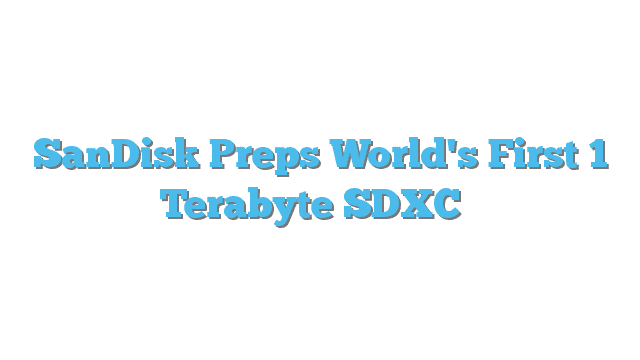If you are looking to expand the memory on your mobile phone or camera and are willing to spend $150 or so, you can buy a microSDXC SanDisk memory card that will give you 256GB of extra space. Before too long though, you may be able to add nearly four times as much memory with a single card — a one terabyte memory card that provides approximately one trillion bytes, or in other words: 1,000 gigabytes of storage capacity.
Yesterday, Western Digital unveiled a prototype of the world’s first one terabyte SD card. The SanDisk 1TB terabyte SDXC card debuted during the opening day of the Photokina photo and video technology trade show in Cologne, Germany. No price has been set, since the card is still in the prototype phase, but videographers and others who need more storage capacity are impressed with the advance.
Storage tech provider Western Digital became the parent company of SanDisk, with its May 2016 acquisition. The company has been continuing its mission to “push the boundaries” of memory for data-intensive uses.
So how much is one terabyte? A terabyte is actually 1,024 gigabytes (GB). We’re talking about monster big capacity here, and in fact, the prefix ‘tera’ is derived from the Greek word for monster. According to the MakeUseOf technology site, one terabyte of storage would equal all of the data you could store on 1,500 of those old-school CD-ROMs that almost no one uses anymore. Stacked on top of one another, those CD-ROMs would reach a height of 39 feet.
512GB Card Debuted in 2014
In a press statement yesterday, Dinesh Bahal, vice president of product management for Western Digital’s content solutions business unit, compared the 1TB prototype to another memory milestone the company reached in 2000.
Sixteen years ago the first SanDisk 64MB SD card was introduced, and today, Bahal said, “We are enabling capacities of 1TB.” Over the years, the goal has remained the same: “to continue to innovate and set the pace for the imaging industry.”
At the previous Photokina conference in 2014 — the event is held biennially — Western Digital unveiled its previous record-breaker: the 512GB SanDisk Extreme Pro SDXC UHS-I memory card, which is now available for purchase at a price of around $600. That card provides write speeds of up to 90MB per second, according to the company.
1TB ‘Seemed Futuristic’ Not Long Ago
Western Digital plans to demonstrate the 1TB prototype and showcase other new offerings for the duration of Photokina, which runs through Sept. 25. Although some of our U.S. readers may not be familiar with Photokina, it’s a sizable event: The previous conference in 2014 featured more than 1,000 exhibitors from 51 countries and attracted over 183,000 visitors from around the world.
“Just a few short years ago, the idea of a 1TB capacity point in an SD card seemed so futuristic — it’s amazing that we’re now at the point where it’s becoming a reality,” cinematographer Sam Nicholson stated in Western Digital’s press release about its latest prototype.
“With the growing demand for applications like VR [virtual reality], we can certainly use 1TB when we’re out shooting continuous high-quality video,” said Nicholson, who is CEO of Stargate Studios and member of the American Society of Cinematographers.
While 1TB is the cutting edge for mobile data storage, solid-state drives have achieved much higher capacities. This past August, for example, competitor Seagate Technology unveiled a demonstration solid-state drive with 60TB of capacity.
Shown during the Flash Memory Summit in California, the 60TB Seagate drive can hold more bits per square inch of disk space than there are number of stars in the Milky Way, the company said; all told, the drive can hold up to 400 million photos or 12,000 DVD movies.
SD vs SDXC
For our less techie readers, it may help to note that SD is short for Secure Digital, and SD cards are designed to provide high-capacity memory in a small size. SD cards are used in mobile devices such as digital cameras, as well as handheld computers, mobile phones, and audio devices.
SanDisk’s new 1TB card uses the newer SDXC standard, with the XC signifying extended capacity. According to the SD Association, the SDXC standard is designed to support memory capacities above 32GB up to 2TB.
“The SDXC standard is enabling the development of higher performance devices like 3D video cameras that store more multimedia content for better user experience.” Ultimately, the Association says, faster transfer speeds and up to 2TB storage will enable fast high-def video recording and downloading in any SDXC device. The “extended capacity” enables improved consecutive photo shooting — 60 frames per second. And, when used in mobile phones, SDXC cards give the ability to download more music, high-def videos and graphic-heavy games more quickly.







